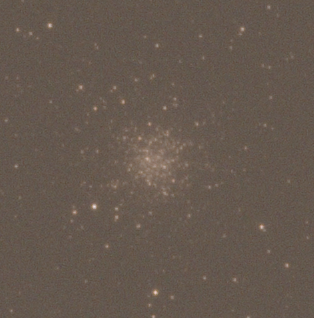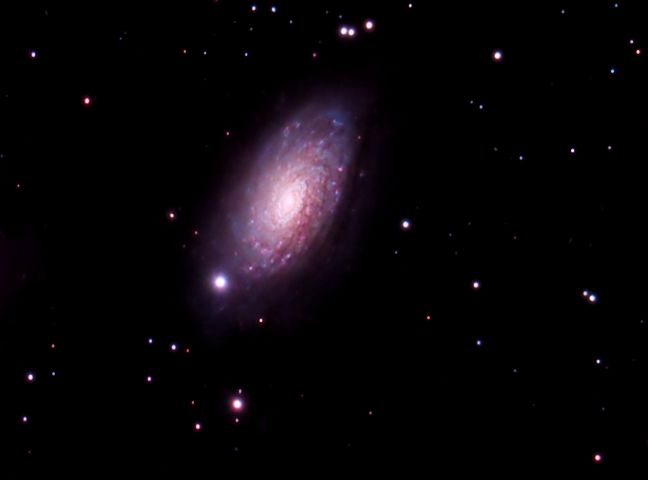Search the Community
Showing results for 'astronomy'.
-
Hi, I’ve watched various videos but cannot find out where I will find the Astronomy macros or how to install then. Is there a cost to doing it? Anyone suggest a good beginners book?
-
Affinity 2.3.0 crashes when charging a .fit file ..
Varesha replied to Varesha's topic in V2 Bugs found on Windows
Hello, Thanks for all answers!! The problem is really a little more curious : A few comments on this: a ) For example, if I create an RGB file as a .fit file with an astronomy program like APP (or SIRIL), then it can be easily opened and edited, as described by Pitufo!!?!?! 😀 b ) If I only create a Ha (for the color of the hydrogen) or OIII file (for oxygen) as one .fit file, then Affinity crashes every time ...!? 🤔 But: c ) The .fit files can be loaded for stacking in Affinity! The "emergency solution" therefore currently leads through the opening in the astro program, subsequent stacking with only one file (!!) and further processing in Affinity. The direct loading of the file would of course be preferable. Lee's answer gives me hope ... 😉 Thank you!! -
I am new to Affinity Photo and use it mostly for Astrophotography stacking and processing. I noticed and could not find info on how to rotate a FITTS file while in the Astronomy Stack feature. Some of my photos had to experience a Meridian flip and must be rotated 180-deg. The manual address rotating in the Document view but I do not think the view while in Stack is Document view. It will rotate but the picture goes back. Also, the View tab only allows a rotation of every 15-deg which takes too much time to rotate. I read that in the Document view there is a rotation command giving more degrees to rotate at one time. So, if you are viewing a FITTs file format; can it be rotated, or do I have to convert all my FITTs files to TIFF files to rotate in a Document view? I doubt Affinity Photo will completely flip my pictures in the Stacking process.
-
There is currently an initiative to make better use of the TIFF format for astronomy. The idea is to use TIFF not only for saving an image but also to store the FITS header in a standard way into the TIFF file. So the exposure time, celestial position, date, gain, astronomical solution , sensor temperature can be stored and read similar as for a FITS file. Benefits: • The TIFF compression algorithm makes the files smaller • The files are readable by almost any image viewer. Astro-TIFF as is called is already available in several programs and more are coming: Image acquisition programs Astro-Tiff compatible: CCDCiel. version 0.9.78 read/write Nina 2.0 beta version SharpCap (beta) INDIGO Image processing programs: Siril version 1.0 just released ASTAP latest versions, read/write, conversion In planning: APT AstroImageJ PixInsight Other program can read TIFF but not the header currently. In INDI The idea is to use this format for 16 bit raw images, so lights, darks, flats and flat-darks/bias files. These images are produced in the thousands. For these files compression is beneficial. The TIFF deflate compression is almost as good as the Rice compression as specified in the FITS standard 4.0. Any further processing results can be stored in FITS. It is possible to convert batch wise between TIFF and FITS possible without loosing header information. The Astro-TIFF specification is here: https://astro-tiff.sourceforge.io/ Note this specification is not set up as a replacement of FITS or other formats. It just proposes a better of use of the existing TIFF file format. Han
-
I have an image here: https://d.pr/f/ajmR49 It has several layers that use perspective active layers. When I resize the document to width 825 (which is the size I need for the printer), the layers with perspective applied don't get properly resized and positioned. Open the file at https://d.pr/f/ajmR49 . Do Document | Resize Document… and enter 825 as the width (let the height auto-calculate). The floating windows get all screwed up. Backing up in the history prior to the resizing does not correctly restore the locations of the floating window layers. sr9-multiverse-astronomy-constellations-evening-1564312.afphoto
-
Hi, When creating an Astronomy Stack, AP automatically inserts a Curves adjustment layer and a Levels adjustment layer above the pixel layer. AFAICT, the default values assigned to these curves and levels is the same, regardless of the colour content of the pixel layer. In other words, AP does not 'normalise' the image - it just applies some default values to it. Neither of these layers has a colour mode assigned - the colour mode picker display is always 'blank'. See the images below. If you then assign a colour mode (eg, RGB), the default adjustment values are reset. So - I have 4 questions :- 1. Why is there no default colour mode assigned to these adjustment layers when creating a new stack ? 2. How are the default values chosen for these adjustment layers ? 3. Why are the default values reset if you select a colour mode ? 4. Why do FITS open with a terrible muddy red/green cast on AP, when they appear as a much crisper neutral grey in other image editors ? (FYI - The debayer setting is correct, and the colour space used in AP is the same as the source image). See the example images below. Gary ===== Default adjustments layers - note there is no colour mode set. Affinity Photo : Unstacked FITS file Other Image Editor : Unstacked FITS file =====
-
The definition is not quite clear, especially because of its vague terms "problem" + "obstacle" + "better solution". (e.g., When is an issue a problem, when is it just a task?) Each of the terms can be individually, depending on the user, while the limiting condition "temporary" would even indicate that current workarounds will lose their character as "workaround" if only Serif does not offer a "better solution" for long enough and thus turn a workaround to a "long term solution" – ironically just by ignoring the issue. As I understand it, a definition of "workaround" must include individual aspects like e.g. "experience", "habit", "expectation", "feeling". The same solution may be perceived as a "workaround" by one person and as a "welcome option" by another. Especially with computer software and interfaces without a "natural" solution of an analog equivalent (e.g. scrolling, zooming, panning, scaling) the expectations are individual and thus a "workaround" versus a correct, sufficient, intuitive or ingenious workflow can hardly be defined unambiguously. [I wouldn't be very surprised if a staff member of Serif (which, among other software developing, focuses on editing astronomy photography) would argue that "space" is unlimited in analog reality and that the endless pasteboard board is therefore a natural equivalent by design + on purpose and a feature that distinguishes Affinity from its competitors.]
-
Created a new Astronomy Stack. Loaded 25 raw picts from Canon (extension CR2) at about 26 megapixels. Click "stack" and wait...CRASH! See attached crash log. At this point I cannot use Affinity Photo for Astro Stacking...I'm bummed.... =( I could stack with my older camera that did 12 megapixels. So might be related to having large images. I plan on stacking 1000x26 MP images later. I was hoping to use Affinity Photo for that. I just bought it. Afiinity Photo crash log.txt
-
I was trying the Astronomy photo stack feature in 1.9.1 for the first time today. I have an iMac using OS X Catalina. I loaded the light frames (by they way, I had to select files and could not load the whole folder, as advertised). I loaded the Bias frames, I loaded the Dark frames, and I loaded the Flat frames. Then I clicked the Stack button. The program searched for bad pixels, and then started to run the stack. In the middle of the stack, THREE TIMES NOW, the program as just crashed to nothing, and I got the "unexpectedly quit" message. This is very disheartening, because I was really looking forward to using this feature (based on youtube videos of it working).
-
I have a very large Star Halo from a very bright star (Altinak) in my astronomy image and I was wondering how to remove the Halso using Affinity Pro. I am very new to using Affiniity Pro so I really don't know where to start. I will provide the URL for the TIFF file if you are willing to help me eliminate the halo. I am basically very happy with everything else. https://www.dropbox.com/s/z95dohtqxxvxzrc/B33.tiff?dl=0
-
Hello, I just downloaded the 10-day trial. I think that time may be a bit short but I'm working with it. My question is concerning supported file types. Does Affinity support FITS format? Flexible Image Transport System (FITS) is an open standard defining a digital file format useful for storage, transmission and processing of scientific and other images. FITS formatted files are probably the most commonly used file formats in astronomy. If this is not a supported type, what is the possibility that is might become a supported image file type? I ask because I do astrophotography and my cameras and capture software saves in FITS format. If Affinity can work directly with FITS format it would save me time from having to first uses another program convert from FITS to TIFF. I've attached one of my FITS files. Many people in the amateur astronomy and astrophotography community use PS. I use a very old CS2 version. I was considering something like CS5 or CS6 but those are now also old versions too. I don't like Adobes subscription and have been looking for other alternatives. I am liking what I see with Affinity. I think that this could easily be used in processing astrophotography images, especially for those already familiar with PS processing. With a few additions, such as supporting the FITS format, I think you might be able to attract astrophotography enthusiasts to Affinity Photo. Thanks. John Schnupp 2017-09-12_23-09-44_Light_Ha_600s__-20C.fit
-
Now that I have made the switch to AP I am re-working many of my astrophotography macros. I will share them here with brief instructions and encourage others to share theirs. All my macros are for Windows OS This set of 3 takes the basic individual monochrome filtered R G and B images and converts each into a colour channel. Load each RGB file separately into AP, Run the respective macro and copy the output of each into a single AP layered document, then set the blend mode of each to add This will output a single RGB non white balanced file grey to blue.afmacro grey to green.afmacro grey to red.afmacro
- 12 replies
-
- astronomy
- astrophotography
-
(and 2 more)
Tagged with:
-
I am still learning my way through AP and have started re-working some of my old images which are now much improved vs my old editing techniques in PS Here is my 1st main attempt using AP This is IC5070 Pelican nebula in Cygnus tone mapped using Sii as Red, Ha as green and Oiii as Blue. 9x5min each colour channel. Stacked and aligned in Astroart, Initial stretching and development in Startools then colour re-combination, balancing, additional tone mapping and sharpening in AP. BTW - AP did these final stages in a fraction of the time PS takes. Clear Skies
-
Why does AP Always Modify White Balance on FITS ===== Hi, I use AP for astronomy stacking, and it works very well. I also use SiriL, because it includes other features such as FHWM mapping, then I process the SiriL stack using AP for colour balance etc. When I import a SiriL stacked FIT into AP, AP automatically creates Levels and Curves layers (good - and these can be disabled), but AP also changes the colour balance of the Background Layer (VERY, VERY BAD - and it doesn't tell you), and there appears to be no way to disable this. So, if I open the SiriL FIT in AP and also in another FIT editor (eg Graphic Converter), the 2 background layers are completely different. The background layer in Graphic Converter is correct, but the background layer in AP has a significant negative shift in the Green channel, as you can see in the histogram attached. So, my question is ... How can I configure AP to NOT fiddle with the colour balance when it opens a FIT ? Many thanks, Gary
-

FITS file format
R C-R replied to John Schnupp's topic in Pre-V2 Archive of Affinity on Desktop Questions (macOS and Windows)
@MikeTO, I think @RickHaines is asking where to find the Astronomy Stack function on the iPad version, not on the Mac version like in your screenshot. -
Hi to all. I previously asked if the Photoshop Astronomy Tools package could be used as a plugin for AP. Since that is not possible, what is the chance of your programmers writing their own code to emulate those tools? I realize that it would entail adding some features to AP to catch up to Photoshop's set of features. Then the astronomy type tools programming could do the emulation. That would open up this fine application to a worldwide group of astrophotographers. I have not used Astronomy tools myself, since I don't have or want Photoshop. Fivel
-
Hi James, Many thanks for that info ... The problem with the AP 'best frames' function is that it is not based on a standard Astronomy metric - eg FWHM. When using the 'select best frames' function, entering a % is essentially a commitment to trash 1-x frames, regardless of how good they are. What would be better is to set a quality threshold - eg select frames with a FWHM <= X. Selecting 'big' stars increases the risk of selecting saturated stars, which leads to an unreliable assessment of image quality, because the brightness profile tends to be that of a truncated cone, rather than Gaussian. It's important to bear in mind that images are usually cropped - what is rubbish in one part of the image doesn't necessarily mean that the entire image is rubbish. What astrophotographers would *love* is for APh to generate a chart displaying the average FWHM for each frame - then the user could select which frames to keep/discard, based on the FWHM and visual inspection - which is necessary to avoid frames being inappropriately discarded because of saturated stars or other artefacts that do not affect the quality of the part of an image containing the target. I hope that makes sense Regards, Gary
-
I am trying to use Affinity to process my astronomy images. I want to make the background sky darker (almost black) and the nebula in the foreground, brighter and more colorful. I suspect this is done through layers ... but how do I do this so the area where the nebula edge meets the background edge is not a sharp border but sort of a blending of one into the other. Is this what feathering is all about? thanks
-
Hi, Thank you for the first response. I will upload the camera files and the Flats, Darks and Bias files into the drop box. https://www.dropbox.com/request/oBrev5Om26Xv1fd71JTK The use of the ZWO Duo-band filter is a good compromise to get both the Ha and the OIII spectrum of astronomical nebulae with only a few exposures. What is needed is a colour camera - like the ASI183MC Pro. The filter description: https://astronomy-imaging-camera.com/product/zwo-duo-band-filter If you isolate the two spectral components Ha and OIII, you can use colour-distorted images like the Hubble colour scale. In the Astropixelprocessor software is the extraction function for the monochrome files Ha and OIII like a keystroke. I miss this feature in Affinity photo and I miss the export of the result as FITS files. Best regards Rainer
-
Thank you all for the replies. I did go ahead and bring in all the FITS files into Affinity Photo astronomy stacking. Some needed to be flipped due to the Meridian flip in that sequence of photos. Affinity Photo did flip the photos that needed to be rotated automatically. The program showed the number of stacked photos, and it matched the number of photos imported. I am happy that I did not have to convert files and flip each one that needed to be corrected for stacking. I am happy with the program and still learning how to use it. I was going to post a picture but could not figure out how to post.
-
Hey Chris, Thanks for your reply But - I don't want AP to 'correct' my gamma unless I ask it to. I've tested this using FITS Liberator, GIMP, PixInSight, QuickFits and SAO - the images displayed by the apps all look the same. BUT - the image displayed by AP is noticeably different - as you can see in the images in my original post, the AP image is much lighter. See the images attached - Graphic Converter on the LEFT, AP on the RIGHT. Using a digital colour meter to measure RGB :- - the background using Graphic Converter is 2, 2, 3, while in AP it is 18, 17, 18 - a faint star in GC is 5, 6, 6, while in AP it is 27, 29, 28 so AP is definitely transforming the image. For AP to be useful for astronomy work, I need it to open FITS without changing anything. How can I get AP to do that ? Gary























